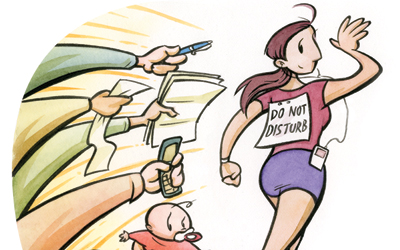It’s 8:25 p.m. and you’re working late. Again. The boss has gone home, along with most of your coworkers. But not you: You’re still chained to your desk, and you’ll probably be there for a while.
Over the last few months you’ve been cranking through work, though. You’ve pulled ahead of your competition, and you figure a significant promotion — along with a bigger paycheck and more responsibility — is right around the corner.
Sure, you feel rundown and you’ve put on some weight. But you just haven’t had much time to sleep, much less shop for and prepare healthy food. And the prospect of squeezing in a workout when there is so much to do seems laughable.
Here’s what you tell yourself: I’ll work out when I clear these projects. I’ll sleep after I get the promotion. I’ll start eating better when the kids start school.
It’s a scenario familiar to many of us: too much on our plates, not enough hours in the day, and a persistent feeling that any time away from work means lost time, money and accomplishments.
Many of us have been brainwashed into thinking that stress and poor health are the price of success. We may even see our rundown bodies as evidence of our unflagging dedication to the demands of our careers.
New research shows that this zero-sum view of work and working out is flawed. Far from detracting from your productivity and efficiency, regular exercise can make you smarter, and more effective, resilient and successful. And this is true whether your “profession” involves tackling corporate mergers or taking your kids to soccer practice.
In addition to helping you look and feel better, time invested in upgrading and maintaining your fitness repays itself many times over in ways that psychologists, brain experts and other researchers are only beginning to understand. And putting even a little effort into upgrading your health and fitness can have a surprisingly dramatic effect on your professional performance.
Need more convincing? Read on.
Fit for Success
You may have been hired for your brain power. But the condition of your body could matter more than you realize, particularly as you climb the corporate ranks. A 2005 survey conducted by TheLadders.com found that 75 percent of top executives considered being physically fit “critical to career success” and being overweight “a serious career impediment” to advancement.
Slender women out-earned their overweight female colleagues by a significant margin. Men of moderate weight, meanwhile, earned more than both slender men and overweight men.
It turns out that employees’ salaries are influenced by how closely their body weight approximates an “ideal,” which frequently and unfairly differs by gender. A study published in the Journal of Applied Psychology in 2011 found that slender women out-earned their overweight female colleagues by a significant margin. Men of moderate weight, meanwhile, earned more than both slender men and overweight men.
Being thin, in other words, tends to be an advantage for women and a disadvantage for men. Being heavy is a disadvantage for both.
It’s unfortunate, to say the least, that these sorts of prejudices persist. Until attitudes change, though, it means that if you’re overweight, you’ll probably be operating at some level of professional disadvantage. Getting into better shape could give your earning power a direct boost; it could also benefit your confidence and self-esteem in ways that amplify your job performance.
That’s why Phyllis R. Stein, a career counselor from Cambridge, Mass., with more than 36 years in the business, says: “Whether you’re looking for your next job or trying to reach the next rung on the corporate ladder, I consider exercise an essential job-related activity.”
Stress Case
Cultural biases notwithstanding, success-oriented people have plenty of good reasons to work out regularly, says Stein. One of the best: Exercise improves energy while decreasing stress and amplifying mental focus.
Consider cortisol, a steroid hormone that regulates your energy throughout the day. Under normal conditions, cortisol levels peak early in the morning to get you going, and then gradually decline as the day progresses, leaving you mellowed out and ready to sleep at bedtime. A hectic work environment can throw this natural circadian cycle into disarray. Commuter traffic, an irate boss or an impending deadline can create small cortisol spikes during your day, each one followed immediately by a sharp decline in energy and mood.
Worse, many stressed-out workers turn to junk food, sugary snacks and caffeinated energy drinks to keep themselves going — all of which can make the hormonal roller-coaster ride even wilder. Months of this routine can exhaust and ultimately kill off some of your brain’s stress-regulating neurons, leaving you perpetually listless.
“When you’re chronically stressed, the normal daily cortisol cycle can flip,” says Tom Nikkola, CSCS, CISSN, director of nutrition and weight management for Life Time Fitness in Chanhassen, Minn. “This can leave you barely able to get out of bed in the morning, but too keyed up to sleep at night.”
Though it may seem like a minor, inevitable annoyance to the ambitious white-collar warrior, sleep deprivation actually comes with a steep economic price. One 2004 study estimated that sleep disruption of various kinds cost Australia more than $4.5 billion annually in the form of lost work, reduced productivity and accidents — 0.8 percent of the gross domestic product.
Here again, exercise can come to the rescue. “Easy movement, like walking or low-key yoga, before bedtime nudges the parasympathetic nervous system into gear, diffusing stress and helping to calm you down,” Nikkola says. Even 10 to 20 minutes of stretching before hitting the sack, for instance, could keep you from tossing and turning, resulting in an additional hour of slumber. And when you’re sleeping better at night, you’re also less likely to reach for the junk food and energy drinks that can wreak havoc with your daily energy cycle.
If you’re willing to kick your intensity up a notch to the “moderate” level (the equivalent of a brisk walk or anything that gets your heart pumping), you get other benefits, including improved mental focus. A 2008 study found that 45 to 60 minutes of a midday group exercise class improved the mood, performance and concentration of white-collar workers.
“The clear and positive benefits of exercising only accrue on the days when it happens,” notes the study’s lead researcher, Jim McKenna, PhD, professor of physical activity and health at Leeds Metropolitan University in the United Kingdom. A second study, published in 2010 in the journal Pain Med, showed that just 10 minutes of exercise produced measurable reductions in anxiety and depression.
So rather than skip that yoga class when you’re facing a day loaded with challenges, it’s probably wise to make it an even higher priority. “You should treat your workout like it’s the most important meeting you have all week,” Nikkola says.
Reclaim Your Brain
“When you’re stressed, your brain busies itself trying to keep you safe from threat — real or imagined,” says Sascha du Lac, PhD, associate professor of neurobiology at the Salk Institute for Biological Studies in San Diego. Self-preserving thoughts can monopolize the brain space that could otherwise be used for scanning your environment, accessing memories and relating to other people.
Fortunately, physical exercise can help heal and hone the very same mental abilities that are sabotaged by everyday stressors.
Picture yourself hiking or running on a trail. Though you’re not conscious of it, this relatively simple, pleasurable activity requires you to make hundreds of split-second choices — about foot placement, balance and navigation, for example — which can improve your capacity to think, feel and relate to others.
“The cerebellum, the area of the brain traditionally associated mainly with movement, is also involved with higher functioning, like planning, socializing, abstract thought — even creativity and emotional intelligence,” explains Elizabeth Beringer, director of the Feldenkrais Institute of San Diego and editor of Embodied Wisdom: The Collected Papers of Moshe Feldenkrais.
“When you exercise regularly, your attention can broaden and shift at will,” adds du Lac, “away from fearful, self-preserving thoughts and onto what’s actually going on around you: the responses of your coworkers, your own insights and ideas, the specific demands of the task at hand.”
Psychological research has also shown that, for many people, a regular exercise routine is a “keystone” habit: a behavior that sets off a chain reaction of seemingly unrelated positive behavioral changes. In a 2006 study published in The British Journal of Health Psychology, researchers found that sedentary people placed on an exercise program voluntarily began smoking less, drinking fewer alcoholic and caffeinated drinks, and eating healthier. They also did more household chores, used their credit cards less often, and kept up more diligently with study and work obligations. Everything in their lives that required self-discipline, in other words, became easier — almost by magic.
“Regular exercise builds self-regulatory resources,” explains Todd Heatherton, PhD, professor of psychology and brain sciences at Dartmouth College and an expert in habitual behavior and addiction. This ability to self-regulate, or exert willpower, say researchers, may be the most significant key to success in any work environment — it’s what allows you to stick to a task when others give up, and to overcome obstacles that at first seem insurmountable.
Small Changes, Real Results
Improvements in mood, energy and productivity aren’t affected significantly by the type of exercise you choose, so don’t fret too much about whether you should be getting your work-enhancing boost from yoga, a Zumba class or a run around the lake. The key is to do something you enjoy — and maybe something a little novel as well.
“Learning is inherently enjoyable to humans,” says Beringer. “It lights up pleasure centers in the brain.” So mix things up, and try to include activities that build in some variety and progression, like team sports, dance or martial arts. (For more work-enhancing exercise choices, see “Fitness Tips for the Time-Starved,” and “The Efficient Workout,” below.)
“Researchers believe that 20 minutes of moderate to vigorous exercise, a few times a week, is all you need to see positive adaptations in the brain.”
Also keep in mind that if your primary fitness goal is to boost your work performance, you can begin with a relatively small commitment of time. “Researchers believe that 20 minutes of moderate to vigorous exercise, a few times a week, is all you need to see positive adaptations in the brain,” says du Lac. “You can do that all at once or in small segments throughout your day.”
And when you can’t spare even that much time and effort, just use your head. “Imaginary movement lights up the same areas in the brain that real movement does,” says du Lac. Clinical studies show that athletes who visualize an unfamiliar exercise see gains in strength and power similar to those who actually practice the movement.
So when work is pushing you to the limit, spend a few minutes daydreaming about a jog down the beach, complete with the feeling of wet sand beneath your feet and the smells and sounds of the ocean. The process could confer at least some of the same benefits of a real workout.
Of course, you’ll get the most significant advantages from moving your entire body on a regular basis. And now that you know the extent to which your professional future depends on it, you may find yourself more motivated to do just that.
The Efficient Workout
If driving to and from the gym for an exercise class just isn’t in the cards, try these easy ways to get in a fat-burning, muscle-building workout on a busy day:
- Hop in the saddle. Consider bike commuting. You get to skip the stress-filled commute, burn some calories, reduce your carbon footprint and save gas money all at the same time. Bonus: It’s tough to flake out on your after-work exercise routine when the bike is your only way home.
- Grab a bell. A kettlebell, that is. Pick up a hefty one at your local sporting-goods store and stash it underneath your desk at work. In 10 minutes, you can do a full-body, low-impact workout that puts the treadmill to shame.
- Climb a skyscraper. Racing up the service stairs of tall city buildings is becoming an increasingly popular urban sport — in large part because it’s tough. If you work in a high-rise, lace on your running shoes, hit the stairs and scamper up 10 or more flights as fast as you can. Take the elevator back down (for recovery), if you’d like, and repeat two to four more times.
- Make like a monkey. Mount a chin-up bar in the doorway to your office, and do a single pull-up every time you go in or out. Can’t do a pull-up yet? Stick with the self-assisted, jump-and-pull variety until you can, which will be soon, because you’ll net dozens of reps per day. To avoid angry memos from the boss, get a bar that mounts over the door jamb — not one that requires screws and a drill.
Fitness Tips for the Time-Starved
“Keeping active doesn’t have to mean taking up residence at the gym,” says Elizabeth Beringer, director of the Feldenkrais Institute of San Diego and editor of Embodied Wisdom: The Collected Papers of Moshe Feldenkrais. “The trick is to make movement a natural part of your day rather than another thing you have to make time for.”
- Sound the alarm. “Staring at a computer screen can pull your attention away from your body. People often sit motionless in front of them for hours on end, and only later realize they’re in pain.” So instead of waiting till your lower back is begging for mercy, set an alarm that tells you to get up and stretch every 20 minutes or so. These micro-breaks will help stave off aches and improve your focus.
- Reach out. Ergonomic experts will tell you to set up your workstation so that everything you need is right in front of you. Beringer suggests going the opposite route: “Extending your arms is extremely pleasurable, and we almost can’t do it enough,” she says. “So put some things you regularly need — important documents, a file cabinet, the phone — an arm’s reach away so that you have to extend and shift in your chair every so often.”
- Rise up. Every hour or so, get out of your chair. Go refill your water bottle. Do some deep lunges and a few pushups. Schedule a walking meeting. Make a point of getting vertical several times throughout your day. You can also experiment with working at a counter or other standing-height surface.
- Go mobile. “Mobile devices like cell phones were designed to help us be more mobile,” says Beringer. “But few people take full advantage of that.” So don’t hunker down at your desk during a cell-phone call when you could be walking around the room or climbing stairs. Attending to your body’s need for movement helps you think, interact and perform your job better.
This article originally appeared as “But I Have to Work” in the October 2012 issue of Experience Life.




This Post Has 0 Comments